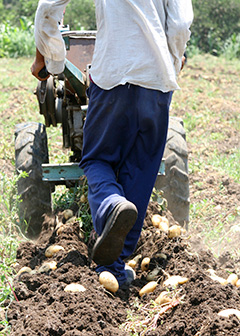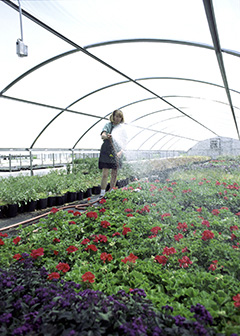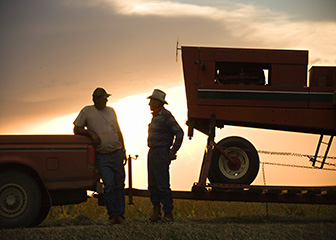
Agricultural workers operate farm machinery.
Agricultural workers maintain the quality of farms, crops, and livestock by operating machinery and doing physical labor under the supervision of agricultural managers.
Duties
Agricultural workers typically do the following:
- Harvest and inspect crops by hand
- Irrigate farm soil and maintain ditches or pipes and pumps
- Direct and monitor the activities of work crews as they plant, weed, or harvest
- Operate and service farm machinery
- Spray fertilizer or pesticide solutions to control insects, fungi, and weeds
- Move shrubs, plants, and trees with wheelbarrows or tractors
- Feed livestock and clean and disinfect their pens, cages, yards, and hutches
- Examine animals to detect symptoms of illness or injury
- Use brands, tags, or tattoos to mark livestock to identify ownership and grade
- Herd livestock to pastures for grazing or to scales, trucks, or other enclosures
- Administer vaccines to protect animals from diseases
The following are types of agricultural workers:
Crop, nursery, and greenhouse farmworkers and laborers do numerous tasks related to growing and harvesting grains, fruits, vegetables, nuts, and other crops. They plant and seed, prune, irrigate, harvest, and pack and load crops for shipment.
Farmworkers also apply pesticides, herbicides, and fertilizers to crops. They repair fences and some farm equipment.
Nursery and greenhouse workers prepare land or greenhouse beds for growing horticultural products, such as trees, plants, flowers, and sod. They also plant, water, prune, weed, and spray the plants. They may cut, roll, and stack sod; stake trees; tie, wrap, and pack plants to fill orders; and dig up or move field-grown shrubs and trees.
Farm and ranch animal farmworkers care for live animals, including cattle, sheep, pigs, goats, horses, poultry, finfish, or shellfish. These animals are usually raised to supply meat, fur, skins, feathers, eggs, milk, or honey.
These farmworkers may feed, herd, brand, weigh, and load animals. They also keep records on animals; examine animals to detect diseases and injuries; and administer medications, vaccinations, or insecticides.
Many workers clean and maintain animal housing areas every day. On dairy farms, animal farmworkers operate milking machines.
Agricultural equipment operators use a variety of farm equipment to plow, sow seeds, and maintain and harvest crops. They may use tractors, fertilizer spreaders, balers, combines, threshers, and trucks. These workers also operate machines to harvest and treat crops, such as conveyor belts, loading machines, separators, cleaners, and dryers. Workers may make adjustments and minor repairs to equipment.
Animal breeders use their knowledge of genetics and animal science to select and breed animals that will produce offspring with desired traits and characteristics. For example, they breed chickens that lay more eggs, pigs that produce leaner meat, and sheep with more desirable wool. Other animal breeders breed and raise cats, dogs, and other household pets.
To know which animals to breed and when to breed them, animal breeders keep detailed records. Breeders note animals’ health, size and weight, and the amount and quality of the product they produce. Animal breeders also track the traits of animals’ offspring.
Some animal breeders work as consultants for farmers, but others breed and raise their own animals for sale or future breeding. Breeders fix and clean animals’ shelters, feed and water animals, and oversee animals' health.









